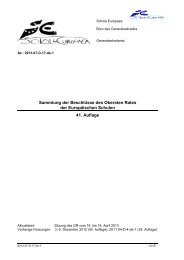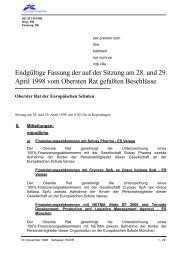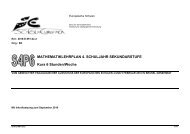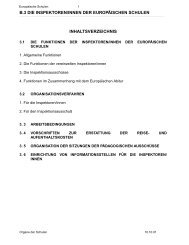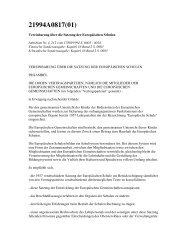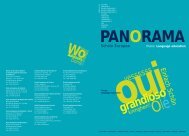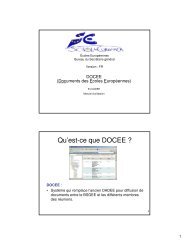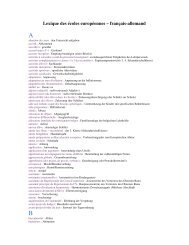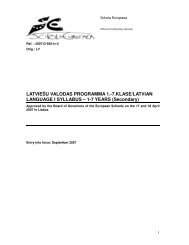External Evaluation of the European Baccalaureate (Annexes)
External Evaluation of the European Baccalaureate (Annexes)
External Evaluation of the European Baccalaureate (Annexes)
Create successful ePaper yourself
Turn your PDF publications into a flip-book with our unique Google optimized e-Paper software.
Each question is subdivided into part questions. Some <strong>of</strong> <strong>the</strong>se<br />
are simple recall questions; some involve drawing labelled<br />
drawings or constructing genetic diagrams. Some questions<br />
involve data analysis and interpretation, but <strong>the</strong> information given<br />
is closely related to <strong>the</strong> topics and cannot be considered to be<br />
unfamiliar as with Question 1 in Paper 2 <strong>of</strong> IB and all <strong>the</strong> questions<br />
in 2806 and many in 2805 with OCR.<br />
Candidates are not required to write discursive essays.<br />
The mark scheme gives solutions to <strong>the</strong> questions and suitable<br />
answers. The mark scheme is not a point mark scheme with<br />
marking points clearly indicated and separated from each o<strong>the</strong>r. In<br />
some cases two answers are required, but three marks are<br />
allocated. It is not clear how <strong>the</strong> three marks are applied.<br />
There is no mention <strong>of</strong> marks for quality <strong>of</strong> written communication<br />
in <strong>the</strong> mark schemes.<br />
The ‘A’ mark is aggregated with <strong>the</strong> marks for <strong>the</strong> ‘Pre-Bac’ and<br />
<strong>the</strong> ‘Bac’ to give a mark that contributes towards a final total out <strong>of</strong><br />
100 for <strong>the</strong> <strong>European</strong> <strong>Baccalaureate</strong>.<br />
The information provided does not mention opportunities for<br />
resitting before certification.<br />
183<br />
All units are available in January and May/June. Retakes <strong>of</strong> Unit<br />
exams are permitted. The best mark for each Unit is used in<br />
aggregation. Resits are available before final aggregation.<br />
IBD(H) is not a modular course.<br />
Examinations are taken at <strong>the</strong> end <strong>of</strong> <strong>the</strong> course in May or<br />
November.<br />
Paper 1 (20%) (60 minutes) 40 multiple choice questions covering<br />
<strong>the</strong> core. No questions on <strong>the</strong> Options are included.<br />
Paper 2 (36%) (135 minutes) written paper. Section A – a data<br />
based question and several short response questions; Section B -<br />
two questions (chosen from four); each question is subdivided into<br />
three sections, some requiring extended responses. The paper is set<br />
on <strong>the</strong> core.<br />
Paper 3 (20%) (75 minutes) written paper. Several short-answer<br />
questions and one extended-response question in each <strong>of</strong> <strong>the</strong> two<br />
chosen options. There are no choices.<br />
Point mark schemes are used for all examinations. Marking points<br />
are separated by semi-colons in <strong>the</strong> mark schemes.<br />
Two marks for quality <strong>of</strong> written communication are awarded for<br />
each question in Section B <strong>of</strong> Paper 3.<br />
Two versions <strong>of</strong> Papers 2 and 3 are set for different Time Zones at<br />
each session – May and November.<br />
Resits are not available before final certification.<br />
These marks are aggregated with marks from o<strong>the</strong>r subject areas to<br />
give a final points score to a maximum <strong>of</strong> 45 for <strong>the</strong> IB diploma.



